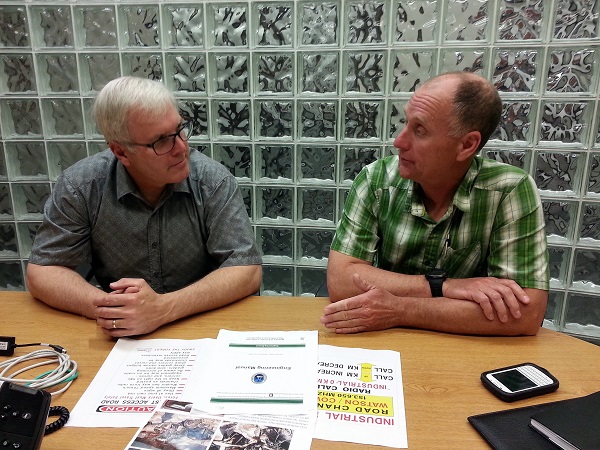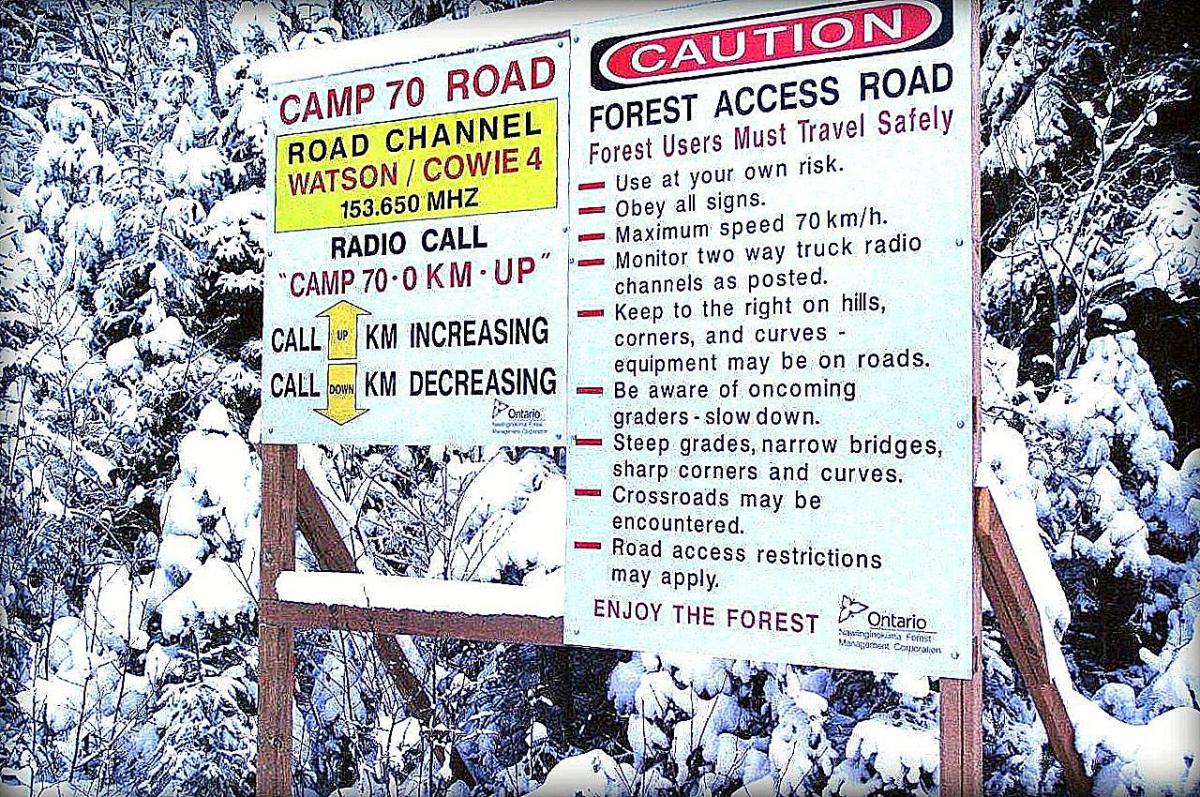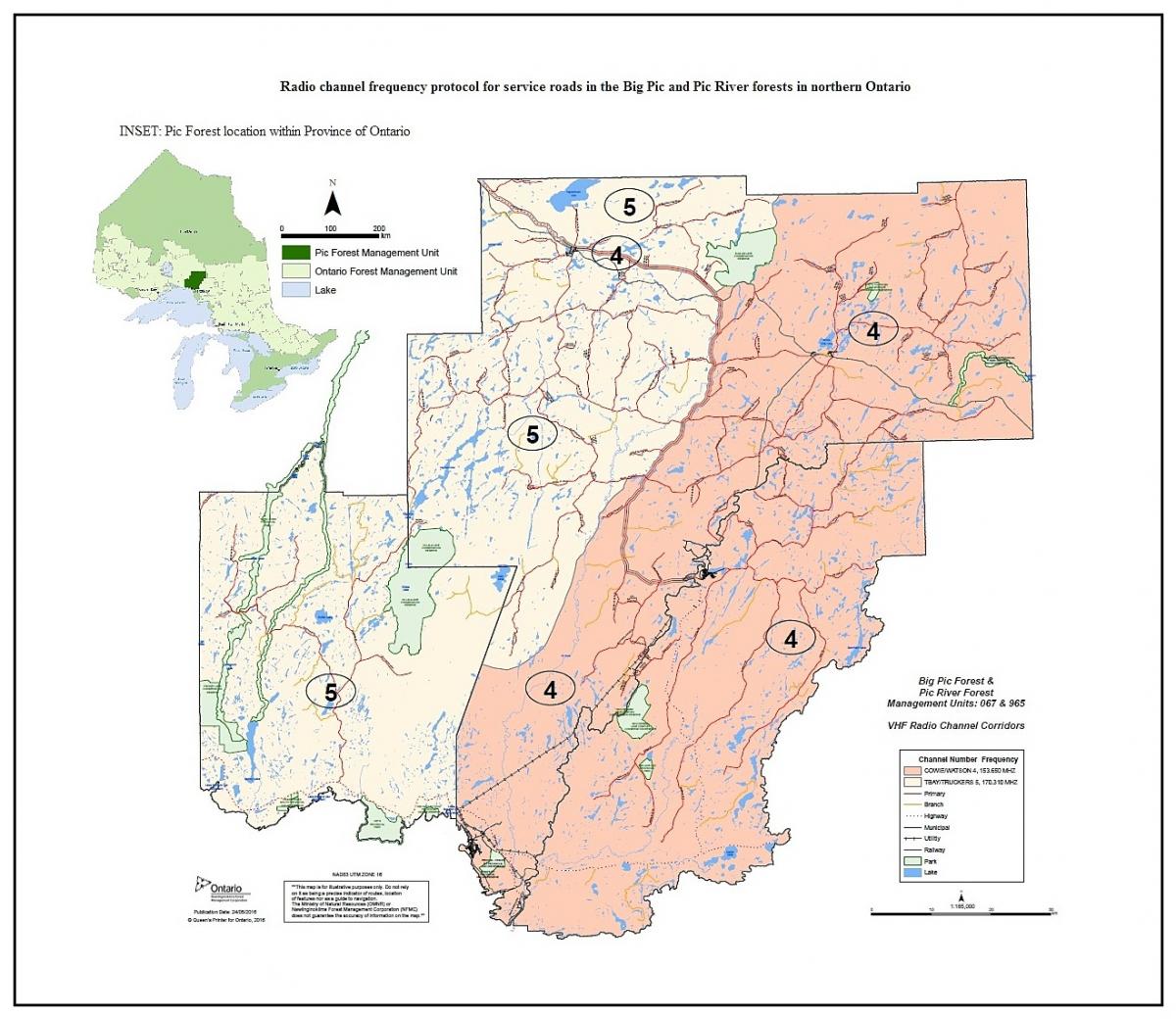
Tom Welton, WSN Industrial Director, and Steve Bros, Acting Operations Manager at the new provincial forest agency Nawiinginokiima Forest Management Corporation (NFMC), discuss the new northern Ontario road sign program with radio channel protocol for rural and forest access roads.
New standard includes radio channel protocol
Whether you’re a mine, forestry, railway, or telecommunications worker, a snowmobiler, or ATV operator, you should know: an average of one person is killed, and many more are injured, on rural roads every year in Ontario.
Eight fatalities in six years
A 2015 industry health and safety report notes logging and silviculture forest management companies in the Ontario forestry sector experienced a total of eight fatalities in the last six years. According to Workplace Safety and Insurance Board statistics, claims for these types of incidents are slowly declining, but the severity remains extreme.
“It’s not just here in Ontario, it’s everywhere – I’ve worked across Canada,” says Steve Bros, Acting Operations Manager at the new provincial government agency, the Nawiinginokiima Forest Management Corporation (NFMC) based in northern Ontario.
“In my 40 years working in the forest, I’ve been to two funerals, provided first-aid to badly injured people, and know of at least two people who were lucky to walk away from head-on collisions – me and my wife,” says Bros. He survived a head-on collision in 1988 (see photo of damaged truck), and four years later, his wife, Sarah, eight months pregnant at the time, also survived a head-on collision with a pick-up truck carrying tree planters.
| In 1988, as a young forester, Steve Bros walked away from this head-on collision on an Ontario forest access road. Four years later, his wife Sarah, eight months pregnant at the time, also survived a head-on collision with a pick-up truck carrying tree planters. |
“She was lucky to get out of that one,” says Bros. “Unfortunately, a friend and coworker of mine was killed in a head-on collision. Also, we had a student in 1989 who was trapped in a half-ton truck for several hours and has a permanent limp because of a head-on collision. In the mid-nineties, because there was so much dust, a guy drove into the back of a parked log truck as the driver was securing the load – because nobody was communicating and roads were poorly marked, the ambulance could not find him; he died.”
Root of the problem
"Depending on which forest they’re in, truck drivers use a different radio channel,” says Dana Bond, NFMC Clerk. “This is the root of the problem: there’s not enough signage posted. It’s not being communicated which truck radio channel to use. So, in our forests, it’s made very clear: Use this channel; call every kilometre – it’s standard.”
Also, the fact that Nawiinginokiima Forest Management Corporation is located on the boundary of two geographic zones magnifies the problem for the agency: truckers come from the northwest region with their own protocols, while truckers from the northeast, largely Quebeckers and French-speaking, have a different system.
| New road signs show truck drivers which radio frequency channel to use and how to communicate the direction they are travelling, and warn public to proceed with caution and obey all signs. |
“For example, on this one road where they were working together all the time, one guy would be calling, ‘I’m going south,’ the other guy would say, ‘I’m going down,’ so nobody would know what direction the trucks were going in,” says Bros.
“Never mind that, there was also the problem with the radio frequencies. The workers from Thunder Bay are used to using Thunder Bay 5 and 6 [radio channel], and the workers from Hearst are used to using 144, and the Timmins channel. Often one group of truckers would be using one frequency, and the other group of truckers would be using another frequency. So one of the first things, of course, is to establish a radio frequency protocol.
“Every year now, NFMC has this comprehensive start-up kit that includes a detailed map showing which frequency drivers should be using, but they don’t need to remember it because every single major road has a sign on it now, identifying the radio channel you need to use and the frequency that it’s on.”
| Every year, NFMC has a comprehensive start-up kit that includes a detailed map showing which frequency drivers should be using, plus every single major road has a sign on it now, identifying the radio channel frequency. Inset map shows the vast geography of Ontario forests with the dark green colour highlighting the Big Pic and Pic River forests. |
“It should be a national best practice”
The NFMC manages the forests covering a land base north of Lake Superior – from Terrace Bay up to Long Lac area, over to Manitouwadge, and is poised to take on the management of the White River forest to the east.
“If you look at all the forests in Ontario, we oversee a huge land base with many forest access roads” says Bond. “It’s a high-risk area – both for industrial traffic and public traffic on those roads. The health and safety issue on those access roads is one of the more important risks to mitigate.
“Hence, this signage standardization; we’re trying to be very proactive in avoiding incidents and accidents,” says Bond. “The new industrial road sign system being implemented in the NFMC license area is for the health and safety benefit of both commercial and industrial truck drivers as well as members of the public.
“I think it’s important to make clear that these sign standards are legislated in British Columbia, including the radio communications protocol,” says Bond. “If the Ontario government and forestry stakeholders have identified a high number of collisions on forest roads, there’s probably a high fatality rate here, too, so I don’t see why a similar protocol wouldn’t come out of that.
“NFMC is being very proactive in doing this. Other forest managers should look at this seriously and adopt it for their own purposes, and that includes Ontario, Quebec, and any other province. It should be a national ‘best practice.’"
Signs of success
“The reason I spoke to Workplace Safety North is this is a personal thing,” says Bros. “We’re seeing signs of success that the new signage and radio protocol is working.
“Now, when I’m on the road, I can actually hear truckers saying, ‘I’m heading “up”’ instead of ‘to’, and that’s huge,” says Bros, “because if some trucker from Thunder Bay comes, he knows, now, that ‘up’ means he’s going in, because the kilometres are increasing.
“The industry is supportive of this because both safety and liability are being taken into account. Everybody’s concerned about it, and they’re so busy, they’re thankful that NFMC has taken the lead to do this.”
For more information, contact your local Health and Safety Specialist.
Related
Safe Driving on Forest Roads training course
Radio channel protocol map for Big Pic, and Pic River Forests in northern Ontario - NFMC
Safe Travel Near Industrial Roads snowmobile safety course
A failure to communicate can cost lives: Safe travel on logging roads


